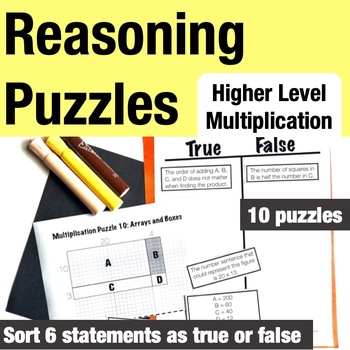Reasoning Puzzles: 2 by 2 Digit Multiplication, Area Model, Partial Product Task
- PDF
Description
Deepen your student's understanding of two by one digit and two by two digit multiplication with these true false puzzles that feature area model, arrays, partial product and that standard algorithm. These puzzles can just be printed and handed out to students to get started. Check out the preview to try a free one.
This is the second in the multiplication series. After learning about the meaning of multiplication in the first set, students will be ready to move on to both single and double digit multiplication in these puzzles.
They will sort true and false statements with a picture puzzle that explores:
Puzzle #1: 2 by 1 digit multiplication
Puzzle #2: 2 by 2 digit multiplication with a rectangular array
Puzzle #3: 2 by 1 digit with a break apart strategy
Puzzle #4: 2 by 1 digit exploring equal groups
Puzzle #5: 3 by 1 digit using visuals of place value blocks
Puzzle #6: 2 by 2 digit using area model (shortcut without the grids)
Puzzle #7: 2 by 2 digit using partial product
Puzzle #8: 3 by 2 digit using traditional or standard algorithm
Puzzle #9: 2 by 2 digit extending strategies to make sense of lattice method
Puzzle #10: 2 by 2 digit full area model with grid lines
This resource is here to help students engage in math talk, test prep for your state standardized tests, and to work through the Standards for Mathematical Practice. In this activity, students decide for themselves whether six statements are true/false about a given puzzle. You can then have them engage in math talk to defend their thinking, and critique the reasoning of others.
Why work on reasoning activities?
The Standards for Mathematical Practice put a focus on the thinking processes of students. There is also some pretty strong research suggesting that students should be engaged in student to student math talk for at least 65% of your math lesson. Giving students these tasks allows them to form their own thoughts, and then work with a team to defend their thinking. If you make it a regular part of your classroom routine (once a week or every other week) students will become more comfortable with math talk.
The puzzles are also fantastic problem solving, critical thinking and deduction activities. This is also a wonderful test prep activity since the Smarter Balanced Assessment Consortium (SBAC) and Partnership for Assessment of Readiness for College and Careers (PARCC) assessments are heavy with problems in which students assess the reasonableness of statements given to them.
How long does this activity last?
Depending on the ability level of your students, each individual activity can take anywhere from 15 to 30 minutes. There are 10 total puzzles with 6 prompts each in this resource.
How do I assess this project?
You can assess what the students do individually if you have them glue their strips to the true/ false template. If you pull together small groups, you could also assess students on their group work skills and level of participation in their group.
How and when do you use this problem type in class?
There are many ways you can use this activity:
- Fast finisher activity
- Morning work
- Intervention block activity
- Small group work
- Homework for students
- Gifted and talented small groups
- Whole class activity
- Parent volunteers can work one on one
- Center activity
Included in this resource:
1. Information for the teacher pages: CCSS alignment, and a sample lesson plan.
2. True/False Template.
3. 10 puzzles, and 10 answer keys with explanations for the false statements. The puzzles cover the concepts of the meaning of multiplication including: traditional algorithm, partial product, area model, and arrays.
These puzzles are challenging, and fun! If you have any questions, or find any problems with your purchase, please contact me as soon as possible so that I may fix any errors.
If you like this activity, try out my other reasoning puzzles:





